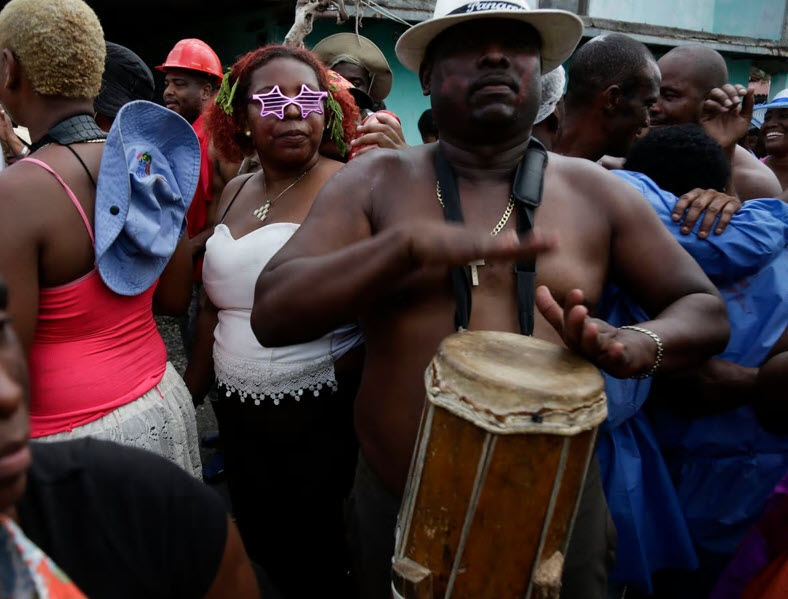A man plays his drum, alerting residents to the start of the “Diablos y Congos” event, an Ash Wednesday ritual that marks the end of Carnival and the start of the Lenten season in Nombre de Dios, Panama, Wednesday, March 6, 2019. The ritual has been recognized as Intangible Cultural Heritage by UNESCO. (Arnulfo Franco/Associated Press)
Under a shelter of dried palm fronds and wobbly limbs, women in colorful outfits and men in tattered clothes — some with foreheads smeared with ash — sing and dance vigorously in a circle to the beat of drums.
Men wearing enormous masks of diabolical characters dance and whip the air to terrorize those present. They lash out at those who dare to dance with them.
The celebration is held on Ash Wednesday by “Afro-colonials” — the descendants of African slaves brought to Panama during Spanish colonialization. The dances and the rituals are known as “congos” and are receiving greater attention since UNESCO designated them as an Intangible Cultural Heritage of Humanity in December.
The festivities commemorate the slave rebellion against the Spanish along Panama’s Caribbean coast. The rituals and dances take a burlesque tone toward the oppression, but also celebrate happiness for the people of Nombre de Dios (Name of God), a farming and fishing town that was founded 510 years ago.
Yodailis Catuy was chosen as this year’s congo queen and was honored by the recognition. The 25-year-old said that even though “congo traditions are in her blood” she never imagined she would be elected queen of the festival.
“I took the responsibility with the people of Nombre de Dios in honor of my grandfather,” she said.
Her grandfather, Robero Catuy, died last year after having served for 30 years as “lead devil,” the designation the town gives to the man who has dressed as a devil for the most years.
The congo queen wears a pollera — a typical combination of blouse and skirt — made of pieces of colorful fabrics, a baggy shirt and a crown made of carboard covered with brightly colored paper and flowers, beads and ribbons.
“I’m very happy, very proud to be living the congo tradition,” Yodailis Catuy said during a break.
Aura Maria Solis, 72, was one of the women singing along with the dancers. “As far back as I can remember my grandmother and my mom danced congo,” she said. “Congo is kind of a mockery and women and men do it.”
The celebration starts before noon, when men and women party through the streets to the rhythm of drums and singing.
It’s called going to “Witch Mountain,” even though there is no mountain and the celebration just takes place in town. As the party moves through the streets women portion out alcohol in gourds called totumas.
“If you don’t want it you just spit it out,” Solis said.
Then the party moves to a ranch for more dancing.
After midday the revelers move out in search of the “devils” — some 20 costumed men together in a home. From there, everyone goes to the palm shelter called the “palace,” surrounded by traditionally dressed women. Two women sing a traditional song called “Devil Tum Tum.”
The men dressed as devils dance and whip anyone who dares to dance with them, including women who wear pants under their skirts to defend against the lashes.
The celebration concludes as the sun sets and the devils are blessed, symbolically freeing them.
